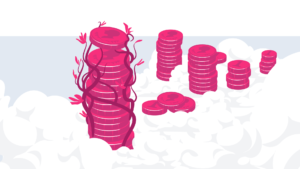Part One: Taking on the market and growing your business

Introduction
The SaaS industry is a competitive environment, with hundreds of thousands of businesses globally, all vying for top spots. We at SaaStock know this better than anyone ‒ we support an international community of over 40,000 founders as they build their businesses and grow. These include some of the world’s most successful SaaS leaders, who’ve grown their startups into thriving businesses.
We invited prominent SaaS leaders to share their expertise and their experiences with our community, as part of SaaStock Remote 2022. SaaStock Remote 2022 was a virtual gathering of some of the leading SaaS founders around the world – every one of them with valuable insights and learnings to share. From the video series of the remote gathering, we’ve put together this blog of the most important insights on building a market, growth, sales and marketing. Put these top tips into practice and you’ll be on track to build an unbeatable, top tier business.
Because there was so much valuable information that came out of the event, we’ve split the blog into two parts. Welcome to Part One, where we tackle the market and maximising sales. Part Two will look at marketing, closing the deal and retaining clients. Good reading!
Alex Theuma
Founder and CEO, SaaStock
Lessons and top tips from our SaaStock community
How to take on the market
Develop an unstoppable go-to-market (GTM) strategy
The correct GTM strategy can make or break a startup. TK Kader, founder of TK, shares his thoughts on the common GTM mistakes made by founders and how to avoid them, starting with perfecting the process to be followed. “Market comes first, then product, and then you have to think about GTM.”
Kader shares the top five mistakes made by founders:
- Planning to use channels when it is too soon and trust hasn’t been built yet.
- Relying on SEO which often has a long, 12-month payoff period.
- Spending all your money on ads on platforms like facebook.
- Buying a sales engagement tool which doesn’t automatically bring results.
- Jumping into execution, without spending enough time thinking about strategy: Positioning, messaging, your value proposition, strategic narrative and ideal customer profiles are all vital aspects of your GTM strategy.
Kader stresses spending time refining your strategy, before going down avenues that aren’t guaranteed to work.
Michael Maimone, VP of Sales at Zoominfo, believes in the need for a unified GTM platform, with a single source of truth.
“Anything that’s happening from an automated or manual standpoint, needs to go through a single unified orchestration layer that will cleanse and append and collapse down duplicates, and give you a single golden record to go federate across all of your platforms.”
This unified GTM platform allows for the collection and aggregation of first party data that’s relevant to your GTM strategy. Add this to verified third party data, and you can build a 360 picture of your customer. This enables personalisation of messages to customers through the appropriate channels. For a detailed look at the customer journey using this unified data platform, watch Maimone’s talk “How to take your GTM motion to the next level” on SaaStock TV.

Besides dealing with data, founders need to decide on their GTM configuration. “It rarely takes a single motion to scale,” says Andrew Davies, CMO at Paddle, who is a proponent of hybrid GTM strategies. A combination of product-led and sales-led motions can lead to a strong GTM strategy.
One common misconception, Davies explains, is that product-led means product-only. “Product-led is the cool kid on the block right now. Everyone’s talking about ‘PLG this’ and ‘PLG that’. But it’s important to know that it doesn’t mean no salespeople, it doesn’t mean no reps.”
Paddle’s research shows a trend towards hybrid GTM strategies: “We’re seeing product-led companies that started out with just a checkout experience serving people everywhere with a freemium product. Then they’re adding sales teams and going up into the enterprise often faster than normal.
Then on the opposite side, we’re seeing a really interesting trend with big scaled public SaaS businesses wanting to understand how they can quickly add product-led lines of business. It’s important to know that this decision of product-led or sales-led, actually should be focused on the buyer.”
Create your own market and dominate it
Geoffrey Moore is a consultant at Wildcat Venture Partners. The author of Crossing the Chasm, Moore understands the difficulties founders experience in creating and owning their own market, and shares some strategies. “The key to this whole framework is something called the technology adoption life cycle”, he says.

This life cycle is divided into five personas in terms of when and why people buy new technology: the technology enthusiast, the visionary, the pragmatist, the conservative and the sceptic. Read more about this model here.
Moore explains the importance of a recognised and respected flagship customer: “For the enthusiasts and visionaries, you need to get one or more flagship customers on board. The flagship customer needs to be a brand name…a company that people really know.”
At this point you may encounter the chasm, where there is no herd mentality behind buying your product yet. To get the pragmatists on board, you have to find a niche market. “You want to win one use case in one vertical market to the point where you are the go-to solution for that use case in that market. And then you can expand into adjacent segments. But you’re kind of working off of that first success,” says Moore.
But how do you cross the chasm? You want your customer to be highly successful with your product. “We say focus on the whole product, not just your product, but the complete solution to the customer’s problem. You bring a whole product to the table, meaning I will bring the complete solution, which means you will add partners where needed,” adds Moore.
Once you’ve successfully managed that, the tornado will begin as customers rush into the category because everyone is perceived to be doing it. Moore explains: “So in a tornado, it’s incredibly important that you capture as much market share as you can in those first couple of years when people have budget for the thing that you do. You’ve got to get there quickly.” Here the conservatives will buy in. At this point you upsell and cross sell. This entire cycle can take about seven or eight years.
Overcome saturated markets
With hundreds of thousands of SaaS companies worldwide, and in every category of product imaginable, it is a seriously saturated market. Globally, the SaaS “category kings” dominate the market, but Peep Laja, founder of B2B message testing platform Wynter, knows how to get your business noticed. Here are his three top tips:
The first is to differentiate through innovation. “You’re objectively better, [when] you’re doing something that no-one else is doing,” says Laja. “When Tinder launched 10 years ago or so, the dating market was already plentiful. So they came out with an innovation, the swiping UX, and became big.”
The second strategy is simple: Spend the money. Laja uses the example of monday.com which was competing in a saturated project management market. “What did they do? They outspent everybody else. If you spend more money than the other people in your category, you will grow. And of course, you need a big fat wallet and VC money to pull this off. They literally bought their way inside into our consideration set.”

Lastly, you need to find your point of difference within your category. Laja shares his tips on setting yourself apart from the rest: “I would go for a different segment in the market, be differentiated for a different use case for a different part of the market. You might not have enough money to win on innovation. You might not have enough money to win on marketing and outspend everybody else, but you can definitely win on brand, on your marketing, positioning and messaging.”
Growth strategies and raising funds
Know your marketing budget
Many founders struggle to build their marketing budgets, and end up guessing at the numbers. Dev Basu, CEO of Powered by Search says that if you’re using a model to provide specific numbers and create plans, your progress towards a target will be predictable.
How do you achieve this? First, figure out how many clicks it will take to get to your pipeline target, and the maximum you can afford. With this maximum budget, you can then work towards an optimistic, realistic and conservative budget. The drivers to help you get there are your metrics. Check your ARR target, your ACV, your sales qualified lead to customer rate or signup to trial conversion rate, and your website conversion rate.

Next, figure out your maximum cost per click. “The gist of it is you want to figure out how many eyeballs do we need? And how much are we willing to pay for those eyeballs, essentially? And you want to work that backwards from the goal that you want to hit,” explains Basu.
Lastly, Basu says you need to think in payback months to be profitable. “If you’re a bootstrap, you want to go somewhere between a four to six month payback period. That’s a Goldilocks zone for being an unstoppable and profitable B2B SaaS company.”
For detailed examples of Basu’s model in action, check out his talk “How to Stop Guessing What Your SaaS Marketing Budget Should Be” on SaaStock TV.
Become a product-led organisation
Todd Olson is the author of The Product-Led Organisation, and CEO/Founder of Pendo. He defines a product-led organisation as one with “companies who put product at the centre of the customer experience, and each and every department thinks about how the product can help their function perform more effectively.”
He takes us through the steps towards being a product-led organisation. First, start being more data driven. Decide on your goals, and work backwards towards achieving them. Spend time on leading indicators like CAC, support costs, win rate and breadth of adoption.
But Olson says that quantitative data is also important as answers lead to actionable insights.
He also recommends “putting product at the centre of the customer experience”. Build reviews into the product experience and keep your user onboarding personal. When launching a SaaS product, customer feedback is key, and should be collected in a single place. Ask yourself: “What’s the aha moment that is magical about your product or your service?”
Utilise customer research for growth
Asia Orangio, Founder and CEO of Demand Maven, specialises in the growth of early and growth stage businesses and takes us through the importance of customer research in helping her clients’ businesses grow.
“We’re going to be asking questions like: How did you find us? How do you typically find solutions or service providers? And then also questions like, what was your ‘aha’ moment? What were your deal breakers? Why did you choose us over maybe other solutions? What were we competing with? How do we improve? What were some other things that you were expecting that maybe we didn’t offer at the time?”

Next, she builds charts with all of the feedback on each question, with tags identifying common themes. These can be used to identify actionable insights. She also works with the charts and filters the information through different scenarios, “extracting insight that we might not have had if we were just taking notes, or if we were just doing ad hoc research or random interviews.” Use this information to determine, for example, your business’ top activation moment and how to activate customers more quickly. The suggested improvements can also turn into feedback on how to retain customers better.
“One of the number one secrets to [customer research] is actually bringing structure to the research, but also visually demonstrating this in some kind of way.”
Leverage partnerships
Stan Masseuras, the VP of Business Development and Partnerships at Intercom, takes us through the best way to find great partnerships to elevate your business.
His first tip is to have a clear strategy and mission for your business, before you begin to approach potential partners. Massueras says that a good partnership “has to be a win for your customer and a win for your partners, which will lead to a win for you”.

Your customer must get more value, functionality and adaptability from the product. Your partner must get a positive ROI from their investment into development on top of your product. And this will drive distribution back to your business. This will lead to an irreplaceable product for your customers which is embedded across their tech stack. And your partners will drive distribution back to you. “You will have this kind of flywheel effect, where you will be able to add additional opportunities at the top of your top of funnel”, says Masseuras.
Great partnerships gravitate around sales, marketing and product. “Your goal is to stay at the epicentre. If you manage to remain at the centre, you will see that naturally you will be creating value for your user. And because you will be providing a positive ROI for your partners, you will have better retention, which will boost distribution, which will make your business more sustainable from a revenue standpoint.”

Masseuras shares his top five tips for good partnerships:
- Focus on technology adjacent to your business.
- Don’t only focus on large companies, but think more broadly. Look for companies with similar numbers of customers to introduce prospects, make your product stickier and attract additional prospects.
- Don’t neglect implementation partners, who are your people on the ground.
- Hire great top talent: “You need to find people who can gravitate between sales and product and marketing and be able to navigate through ambiguity. They need to be independent; they need to take initiative.”
- Check in with your KPIs: Referred revenue, assisted revenue, stage one opportunities, assisted expansion value, and churn-save.
Raise a successful seed round
Elizabeth Yin has reviewed over 30 000 pitch decks in the last few years alone. She is the Co-Founder and Partner at Hustle Fund, and very well placed to share her thoughts on raising a seed round.
The world has gone remote since the start of the pandemic, which might seem to make reaching investors easier. But Yin says, “what most people don’t know is that US investors actually have to jump through a lot of hoops in order to invest internationally. So if a US VC has a choice between investing in a US company, or an international company, they will generally do what is easier if the two companies are deemed to be the same.” So if you do want to raise money from a US investor, it’s easier to get funded as a US incorporated company. “This is a question that every founder generally doesn’t ask themselves, but it is really important when you’re thinking about pitching.”
And what to do when you are unsure of your fundraising stage? “In a market like this, where everyone is all over the place, what I would do is I would take your best guess as to where you are. Maybe you’re straddling pre-seed and seed, maybe you’re struggling with seed or post-seed, and I would try to pitch investors in both and just get feedback and be flexible on your fundraising plans.” Create a couple of fundraising plans. And focus them on growth. “Because investors don’t want to be funding salaries or your burn rate, they want to be funding growth.” says Yin.

Create simple projections, because many investors will ask for them. “I think that it is fair game to do a year of projections, because you should know what you are going to be spending your money on this year. And you can make some best guesses around what traction levels you can get to based on some of your experiments for the next few months or a year.”
Lastly, Yin suggests creating a sense of urgency amongst investors. “You have to create FOMO as a founder. You should be making lists of investors, getting meetings with them, packing the meetings in. When you think about it, investors have zero incentive to invest today, if the deal will still be on the table three months from now.” Close the deal based on the momentum of the meetings you set up.

Conclusion
We understand that for every founder there are a challenging number of tasks on your business ‘to-do’ list. But with the help of SaaStock, our community of SaaS leaders, and all the insights they have to share, you can build an unbeatable SaaS company.
Don’t miss Part Two of this blog on How to Build an Unbeatable SaaS Company, where we’ll be sharing further advice from the experts. Next up: Marketing, sales and – that all important factor – customer retention.
SaaStock is heading across the pond to the Austin Marriott Downtown in Austin, Texas 31 May – 2 June 2023 for SaaStock USA! Buy your tickets now!






